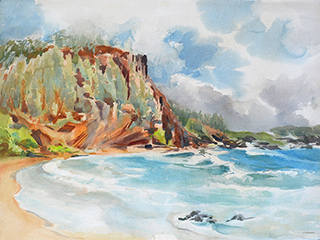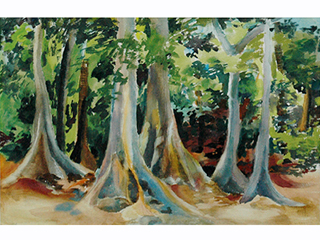The story of women artists in Hawai‘i begins well before and beyond The Seven’s two-year existence. As early as 1880, Helen Whitney Kelley and Helen Thomas Dranga began turning out beloved depictions of the islands’ spectacular scenery, subtly challenging the monopoly set by their well-known male contemporaries, such as D. Howard Hitchcock and Lionel Walden.
 |
| Juliette May Fraser |
By the early 20th century, kamaʻāina artists Blasingame, Juliette May Fraser and Cornelia MacIntyre Foley had trained on the US mainland and in Europe, returned to Hawai‘i, and taken on pupils there, while cultivating personal styles that would accelerate the advent of a regional style of modernism. Working alongside other women who traveled to the islands in the early 20th century, including Lynch, Russell, Tennent and Vitousek, these artists transformed the concept of “island art” from Hawai‘i’s male-dominated environmental imagery into a more nuanced arena that reflected various modernist trends growing across European at that time. Several would also play instrumental roles in the war effort, designing camouflage for local artillery units and creating large-scale murals at local military bases to encourage the soldiers deployed in the Pacific.
 |
Juliette May Fraser
Camouflage Rhythms
1940s
Fraser and the lei sellers developed a system consisting of cutting burlap and recycled fabric into strips, dyeing and configuring the strips to blend in with specific areas around the islands, and then weaving the strips onto large-scale nets, often completed while singing Hawaiian songs.
|
In the later 20th century, several other figures of note emerged to continue the tradition of women artists driving Hawaiian art forward. Betty Hay Freeland and Martha Greenwell pursued seascape and landscape painting in Hawai‘i on their own terms, while batik specialist Yvonne Cheng and graphic artist Pegge Hopper expanded upon Tennent’s genre of the Hawaiian wahine (woman).
Honolulu-born artist Juliette May Fraser is perhaps best known for the murals she painted both in Hawaii and around the globe. She portrayed Hawaiian legends along with other themes through linoleum cut, oil painting, ceramics, and fresco.
Juliette May Fraser was born on January 27, 1887 during the reign of King Kalakaua in Honolulu. After graduating from Wellesley College in Massachusetts, she worked as an educator, like her mother and father who had come to the islands to teach. "That was practically the only thing a woman could do then," she told an interviewer a few years before her death in 1983. Her comments with regard to her education at Wellesly were that, “Wellesley had excellent art history. They did not have very good--they were not so much interested in art practice. They had some, but even the teachers knew that it wasn't an art school standard. It didn't pretend to be.” She took architecture classes but since Fraser didn’t receive any practical art training, she studied with various teachers and ultimately decided to attend the Art Students League in New York.
 |
Juliette May Fraser
Little Teacher
1952
Linoleum Cut Lithograph
|
Fraser returned to Honolulu, taught for a few more years before she received a commission to paint a mural for Mrs. Charles Adams, grandmother of Ben Dillingham. That opportunity placed her on a lifelong path of painting murals, from the World's Fair in San Francisco to Ipapandi Chapel on Chios Island, Greece, where her work was so beloved that the chapel's street was named after her.
 |
Juliette May Fraser
Makahiki Ho'okupu
1939
Charcoal and sanguine mural on masonite
Made for the 1939 San Francisco International Exposition,
presented to the Library in 1977 by the Hawaii Visitors Bureau and Chamber of Commerce
|
Makahiki Ho'okupu (Harvest Celebration) was created by Fraser in 1939 for the Hawaii pavilion at the San Francisco World's Fair. The 50-foot charcoal and sanguine mural (on 13 masonite panels) depicting harvest and gift-giving ceremony remained in storage until 1980, when it was rededicated and placed in Hamilton Library on the artist's 93rd birthday.
At the University of Hawaii in Honolulu, Fraser's fresco 'Air', (ca 1953) is the largest and most complex of the frescoes in Bilger Hall, and depicts the land-linked culture that sustained early Hawaiian people.
The work of kama'aina (Hawaii born) Juliette May Fraser, can today be found in many Hawaii public buildings. In 1934-35, Faser executed a series of murals based on the legends of Hawaii for the Hawaii State Library. In 1934, she was invited to create a work of art for a public place by the Federal Work Progress Administration and the Federal Emergency Relief Administration which took a year to complete. For three months she received $35 a week to work on the project however, when the funds ran out, she continued on her own until the murals were completed. The murals, which extend from floor to ceiling, depict Hawaiian legends along with additional panels in the room which display various marine life and Hawaii flora and fauna. The murals were unveiled on March 14, 1935 to the general public.
 |
Juliette May Fraser
Hoonanea (Quiet Chat between Friends)
1944
Drypoint
6 x 5 inches
Fine Arts Museums of San Francisco |
Fraser is also noted for her printworks, and was associated with Honolulu Printmakers, which is said to be the oldest continuously active printmaking organization in the United States. The group was founded in 1928 by a group of local artists in an effort to encourage the art of printmaking in Hawaii. Each year, one of the organization's members is selected to create a special print. Along with Juliette May Fraser, some of the printmakers of yesteryear - John Melville Kelly, Huc-Mazelet Luquiens, Cornelia Macintyre Foley, Isami Doi, Madge Tennant, Jean Charlot, John Young and others - became world-renowned artists, their prints now demanding much higher sums than the original $5 price.
 |
Juliette May Fraser
Hawaiian Nativity
1958
Fresco
4 1/2 × 8 ft.
St. Catherine’s Catholic Church, Kapaʻa, Kauai, Hawaii.
Photo: Timothy T. De La Vega, 1999. |
In 1958, Fraser created the above mural for the newly built St. Catherine’s Catholic Church in Kapa‘a, Kauai, commonly referred to as Hawaiian Nativity. Covering the makai (sea-facing) wall, it shows Hawaiians of various ethnicities presenting ho‘okupu (gifts) to the newborn Christ child, who sits on his mother’s lap. She wanted the painting to be modern and “international in flavor,” she said, reflecting Hawaii’s ethnic diversity.
Instead of a donkey, a jeep has brought the holy couple, who are portrayed as Native Hawaiian, to the place of their son’s birth. The license plate reads, “4-20-58,” the date on which St. Catherine’s was dedicated. Mary wears a muumuu and lei, while Joseph stands behind her with a sugar cane stalk. “The Holy Child is hapa [mixed race] with blond hair and strong Polynesian features,” writes Anthony Sommer in the 1999 article for the Honolulu Star-Bulletin that introduced me to this painting. That Jesus’s skin tone is the lightest of the bunch might be regarded by some as problematic, a subtle reinforcer of racial hierarchy. However, it might be the artist’s attempt to show a multiracial Christ, bearing the features of different peoples.
In Fraser’s fresco, locals approach with ho‘okupu, the fruits of their personal labors given freely as offerings in expression of gratitude, respect, and aloha. Filipino fishermen present their freshest catch, and Portuguese goatherds (as the artist identified them) come with their flocks; they are greeted by a Chinese angel in a T-shirt, jeans, a sideways ballcap, and flip-flops. From the right, a Hawaiian ali‘i (hereditary noble) comes with the gift of an ʻahu ʻula (feathered cloak), made only for royalty. He stands in line behind a child who offers Jesus a lei (flower garland). Traditionally, ho‘okupu are given to an akua (god), king, priest, doctor, or host, so this painting acknowledges Jesus as fulfilling all those roles.
Juliette May Fraser Kana Wrestling the Turtle
Fresco
1954
Hawaii State Museum
Juliette May Fraser died in July of 1983 in Honolulu, Hawaii at the age of 96.
Sources________________________________________________________________
The Watumull Foundation, Oral History Project, Interview with Juliette May Fraser, Honolulu, Hawaii, 1979.
Art & Theology Revitalizing the Christian imagination through painting, poetry, music, and more, https://artandtheology.org/tag/juliette-may-fraser/, retrieved April 19, 2021
Fine Arts Museums of San Francisco, https://art.famsf.org/juliette-may-fraser/hoonanea-means-quiet-chat-between-old-friends-l, retrieved April 19, 2021
Mutual Art.com, https://www.mutualart.com/Exhibition/Camouflage-Rhythms--Artwork-by-Juliette-/3597EABE2D690619, Honolulu Museum of Art, retrieved April 19, 2021






































